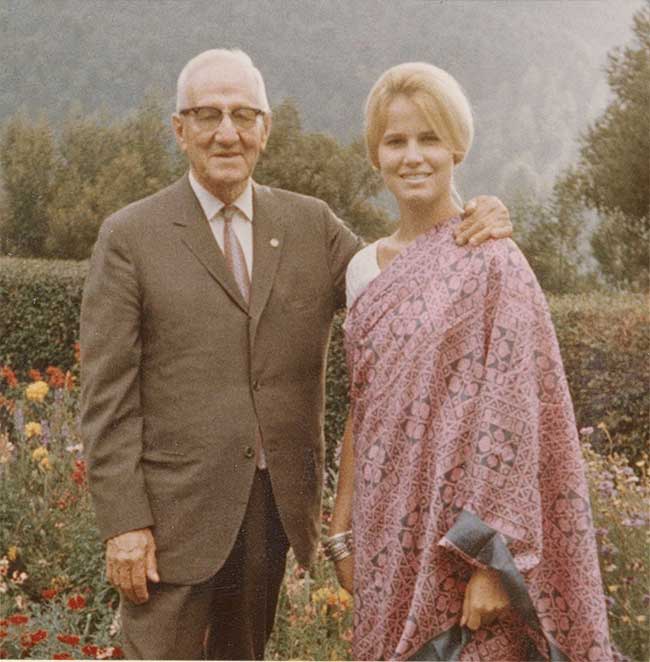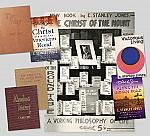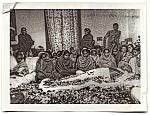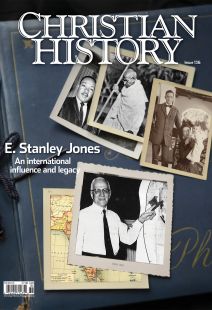My grandfather, evangelist and prophet

[Stanley Jones with Anne Mathews-Younes. Image courtesy of Anne Mathews-Younes]
It is easy to take things for granted in one’s own family. So it was with me and my grandfather, E. Stanley Jones. To me he was just my grandfather who traveled a lot! But now it is fascinating and rewarding to see and understand him as a real person and realize what an exceptional human being he was. Though in his day he was known all over the world, it was India that gave him the ultimate challenge; and India was the anvil on which he tempered and solidified his faith.
As a teenager he ran with a gang. Despite this he was receptive when a visiting evangelist spoke on what Christ meant to him. My grandfather and his friends had planned to disrupt the service, but that disruption did not happen. To the astonishment and annoyance of his friends, he responded to the evangelist’s call with a dramatic conversion that changed his life. He had planned to be a lawyer, and, considering his persuasiveness for the cause of Christ, he would have been an exceptional one. But once he assumed the responsibilities of faithful discipleship, he never turned back.
One-way passage
He went to India in 1907 as a missionary when he was just 23 years old. Mission boards treated new missionaries with astonishing casualness in those days. They gave no orientation—to country, customs, or climate, or even how to get around.
He received a one-way ship passage from New York City to Bombay which took six weeks. He had received the name of his ultimate destination, but getting there was up to him. My grandfather told the story of the 20-hour train ride to his final destination—Lucknow—in the northern part of the country. He found himself in a compartment with a well-educated, English-speaking Muslim gentleman. Full of enthusiasm he read the Sermon on the Mount, expecting the man to be overwhelmed and immediately converted. Instead the man said, “We have the same thing in our Sacred Book.”
This was the first time my grandfather had come up against the “all religions are the same—only the paths are different” attitude so widely held in the non-Christian world. It shook him. But it also made him face squarely, at a very early point, the question of whether he was going to argue or debate with non-Christians to prove Christianity right, or use some other way. He followed another way. I think that this was a crucial decision that contributed to his great effectiveness.
My grandfather’s first church was a British, American, and Anglo–Indian church in Lucknow. He successfully added members to the church, but felt that the great masses of India were beyond his reach. He also felt uneasiness and alarm that new converts were encouraged to reject their identification with Indian culture when accepting their new faith, becoming aliens in their own country. That did not seem right. He became convinced that Christianity could be truly indigenous in India, as well as anywhere else in the world. This conviction was an important contribution to both mission work and evangelism.
After he married my grandmother, they went to Sitapur, a city of about 40,000. There he first came in real contact with educated non-Christians. A casual remark by a Hindu judge made him ponder his whole approach to the non-Christian world (see p. 16). This dramatically changed my grandfather’s focus; he had to decide what was really essential and what was nonessential in the system that had been built up around Jesus.
He spoke constantly to ever-growing audiences of educated non-Christians and presented Christ untangled from the trappings of Western civilization: a universal Christ, belonging to all cultures and races and the answer to ALL human need. His audience grew interested in this Christ. For Jones it was not the superiority of Christianity, but the all-sufficiency of Christ that is the foundation of Christian mission.
My grandfather held his lectures (not sermons) in public halls, a neutral ground for non-Christians. After the lecture the next two hours were reserved for questions from the audience. When I traveled with him and listened to him speak, people were hanging at the windows to hear him. And when he finished speaking, the questions abounded. I was shocked and certain he could not answer these hard questions. I remember slipping lower and lower in my seat, waiting for the humiliation. But to my real surprise (and relief), not only did he answer them, he did so well and never in a provocative, testy, or argumentative manner.
Always an evangelist
My father often said my grandfather was the ablest interpreter of the gospel for the present day of anyone he had ever heard. Perhaps in the early years, Jones would have identified himself as a “soul winner,” but over time he broadened his perspective. He became interested in body, mind, and spirit—the whole person. He saw the gospel of Jesus Christ enabling fractured and partial persons to become whole.
I think his most original book was The Way, in which he elaborated on the idea that the Christian Way is written into the texture of life. It is life. He points out the striking words in John 1:3: “And without him was not anything made that was made.” The stamp of Christ exists on everything, and life is made to work through Christ. And in following Jesus Christ, we set ourselves upon that “WAY.”
My mother tells me of when Boston University honored Dr. Martin Luther King Jr. prior to his leaving for Sweden to receive the 1964 Nobel Peace Prize. At the reception my mother was introduced to Dr. King as the daughter of Jones. He immediately became very serious and said to my mother, “Your father was a very important person to me, for it was his book on Mahatma Gandhi that triggered my use of Gandhi’s method of nonviolence as a weapon for our own people’s freedom in the United States.” King continued that though he had been very familiar with the writings on Gandhi and interested in his method of nonviolence for years, it had not “clicked” with him until he read my grandfather’s book that it could be useful in the United States.
Investing in Others
He was a wonderful grandfather and lots of fun. As I was growing up, he spent every Christmas with us, and his arrival was a time of great anticipation because he played with us. He particularly loved to swim and watch baseball. He was an excellent athlete. I traveled with him as a young adult to Africa and India. Up until the age of 87, he kept up a rigorous and active life. It’s estimated that he preached more than 60,000 sermons—sometimes five to seven per day. I heard him preach that many times in a day. I was tired. He was not.
He always did his daily exercises (even 30 pushups). But in 1971, after a strenuous two months of speaking 154 times in Japan, he suffered a brain stem stroke. After some months in rehabilitation hospitals, he asked to return to India. The doctors concurred, and we took him back to India to live. By faith and determination, he managed to regain mobility and the ability to preach publicly—some 50 times—despite major speech difficulties.
He wrote to us in 1972 that he felt that the year for him had required the practical application of all they had been preaching—the year of using his infirmities. When life says, “No,” God still says, “Yes,” and such was the affirmation he made in his last book, The Divine Yes. He died in India in January 1973. Nearly 50 years after his death, I find that his books and sermons (many written in the 1930s and 1940s) are not out of date and with few exceptions are entirely relevant to today’s world. Just think what he could have done with the Internet!
He foresaw where the great issues would be and spoke to them long before they were recognized—often in the face of great unpopularity and even antagonism and derision. I think that he was something of a prophet, and he laid his honors—and he did receive them—at the feet of Jesus Christ. CH
By Anne Mathews-Younes
[Christian History originally published this article in Christian History Issue #136 in 2020]
Anne Mathews-Younes is board president of the E. Stanley Jones Foundation, from whose website this is adapted. She is a practicing psychologist, the author of The Life and Ministry of Mary Webster and A History of the Christian Ashrams in North America, and the series editor of 16 reprints of her grandfather’s works.Next articles
Brother Stanley’s legacy: A reflection
He preached extensively in almost every country of the world, which gave him a firsthand view that few people on the planet had
Stephen RankinE. Stanley Jones: Recommended Resources 136
Learn more about E. Stanley Jones and his context with these resources selected by this issue’s authors and our editorial staff
the editorsSalt and a narrow escape
The unruly crowd surrounded Mabel's car, rocking it
Martha Gunsalus ChamberlainSupport us
Christian History Institute (CHI) is a non-profit Pennsylvania corporation founded in 1982. Your donations support the continuation of this ministry
Donate






